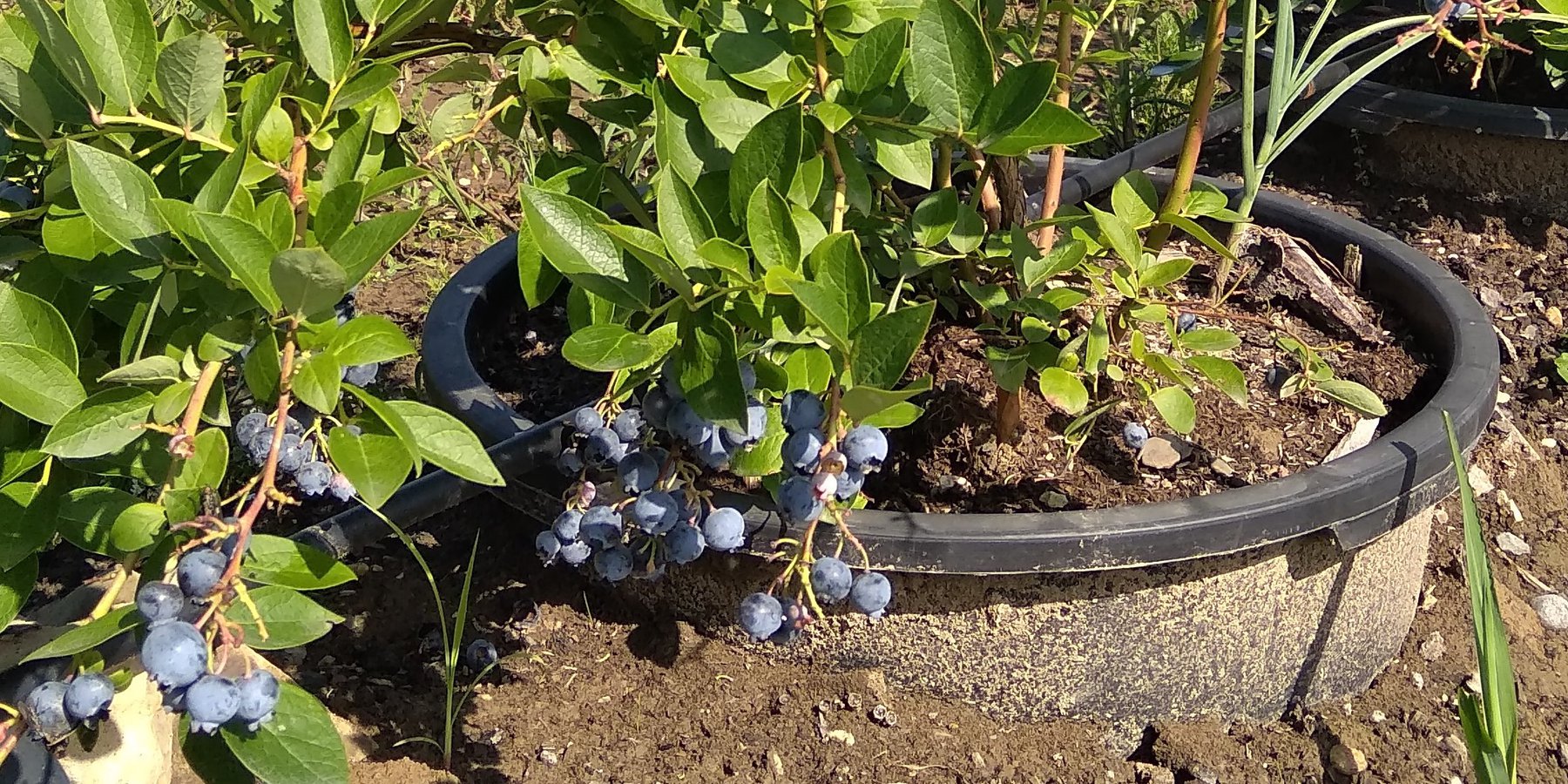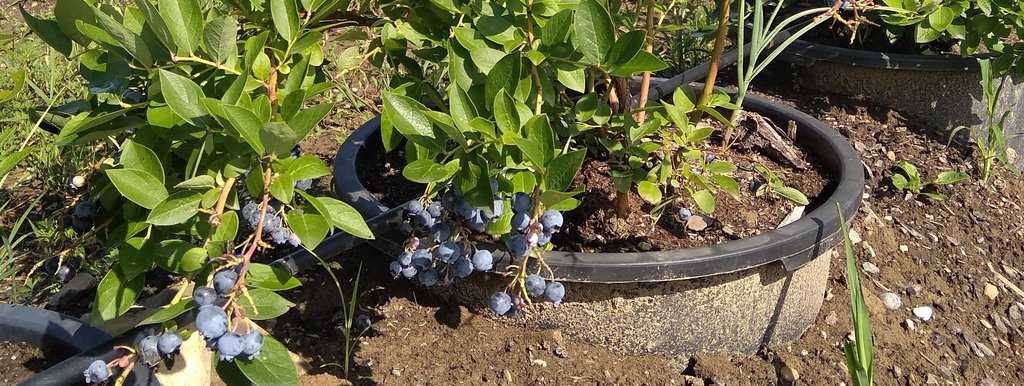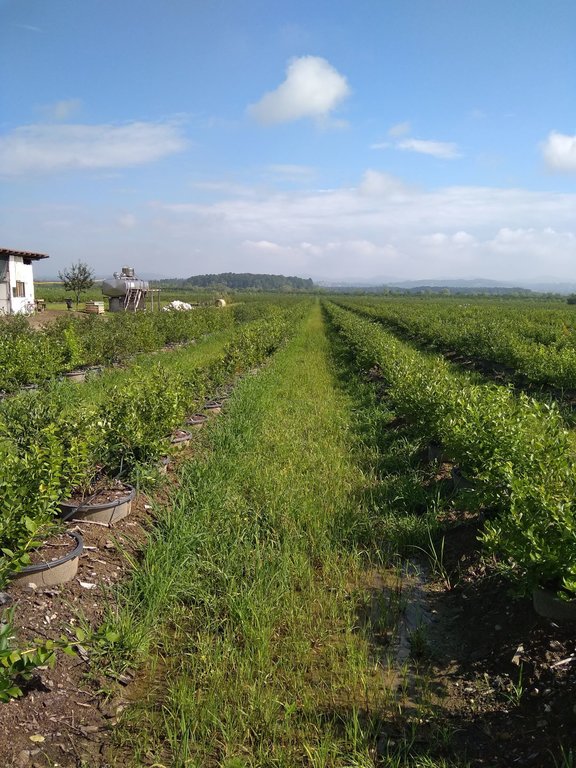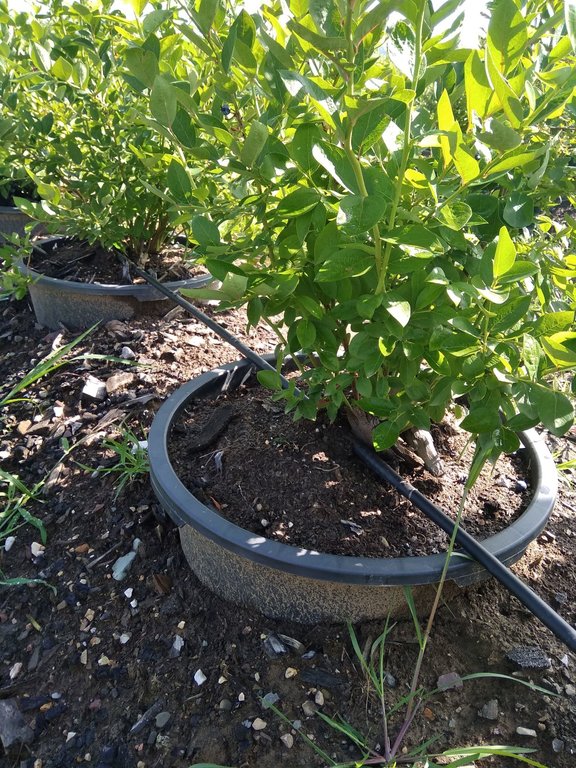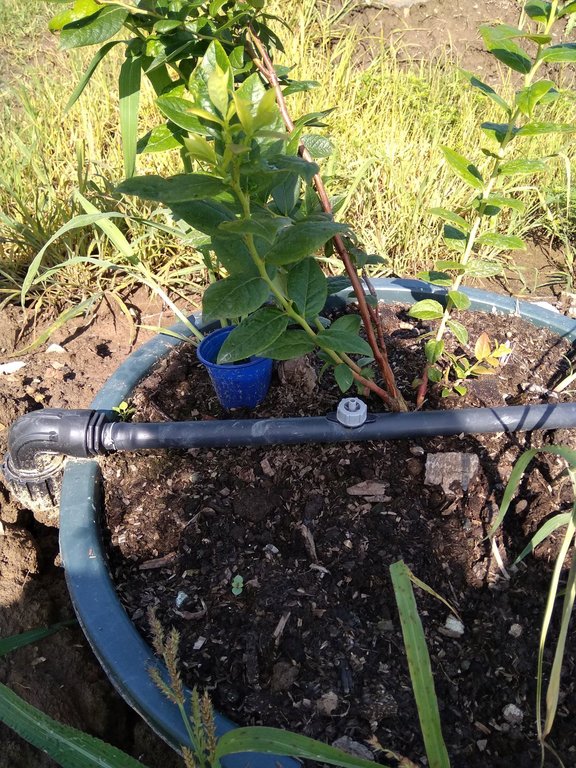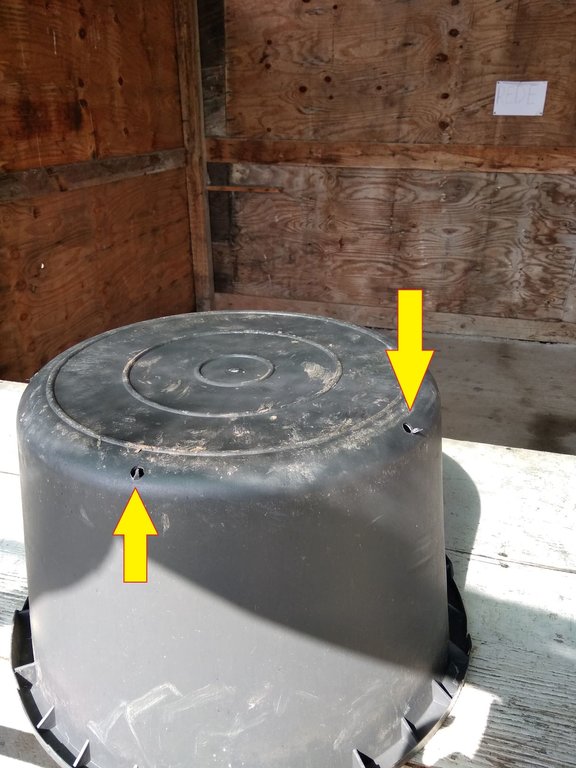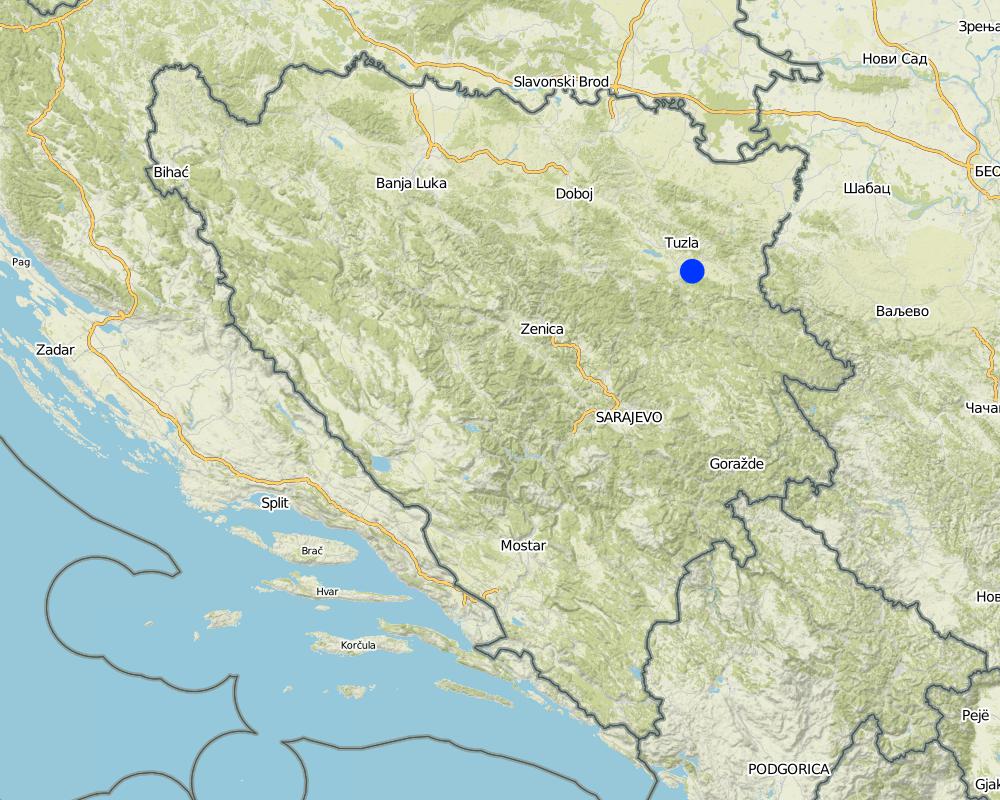Cultivation of blueberries on infertile/degraded soils using plant pots [Bosnia and Herzegovina]
- Creation:
- Update:
- Compiler: Melisa Ljusa
- Editor: –
- Reviewers: Rima Mekdaschi Studer, THEODORA FETSI, Donia Mühlematter
Kontejnerski uzgoj borovnice na neplodnim ili degradiranim tlima
technologies_4126 - Bosnia and Herzegovina
View sections
Expand all Collapse all1. General information
1.2 Contact details of resource persons and institutions involved in the assessment and documentation of the Technology
Key resource person(s)
SLM specialist:
SLM specialist:
Čustović Hamid
++387 33 22 57 27 / ++387 61 77 52 11
custovic.hamid@gmail.com / h.custovic@ppf.unsa.ba
Universiyt of Sarajevo, Faculty of Agriculture and Food Sciences
Zmaja od Bosne 8, Kampus UNSA, 71000 Sarajevo
Bosnia and Herzegovina
co-compiler:
Agronomist of the Živinice Municipality:
Butković Mirsad
++387 35 74 33 01
mirsad@opcinazivinice.ba
Municipality of Živinice - Department of Local Economic Development, Finance and Treasury
Alije Izetbegovića 28, 75270 Živinice
Bosnia and Herzegovina
land user:
Đogić Alija
1.3 Conditions regarding the use of data documented through WOCAT
When were the data compiled (in the field)?
10/07/2018
The compiler and key resource person(s) accept the conditions regarding the use of data documented through WOCAT:
Yes
1.4 Declaration on sustainability of the described Technology
Is the Technology described here problematic with regard to land degradation, so that it cannot be declared a sustainable land management technology?
No
2. Description of the SLM Technology
2.1 Short description of the Technology
Definition of the Technology:
Establishment of blueberries cultivation in plant pots on soils with bad physical or chemical properties. The technology improves productivity and generates income for the farmers. The implementation requires drip irrigation system.
2.2 Detailed description of the Technology
Description:
The cultivation of blueberries in plant pots has been successfully implemented in the area of Živinice municipality - on soils of poor composition, physical properties and low fertility. Many efforts have been made to introduce a conventional production of blueberries but did not bring the expected results due to the bad soil quality.
The soil (Stagnogley) is poorly permeable to water, so even moderate rainfalls cause water remain on the surface, making it difficult or completely impossible to cultivate the land. In addition, soils of high acidity are required for the successful cultivation of blueberries. Planting blueberries in a conventional way is often carried out on soils where the acidity is increased by various additives (often with wood sawdust or similar wooden materials). Practical experience has showed that in the course of time the acidic properties of the soil in the zone of the development of the blueberry root change, i.e. soil/substrate acidity decreases due to resorption processes on the primary soil. Todays' market offers multi-component substrates for the cultivation of blueberries, which, in addition to their adequate acidity, have other properties necessary for a good development of the blueberry's root system. These substrates were also used in some localities of the municipality of Živinice in conventional or modified conventional planting of blueberries (on embankments using soil and commercial substrates). This technique did not yield satisfactory results, probably because of the loss of substrate properties (decrease of soil acidity) due to resorption to the nearby original soil. The substrate keeps its desirable properties much longer if it is put into the planting where blueberries are being planted.
The basic advantage of this technology is its ability to be applied on practically all soils of poor agricultural-productive properties, including heavily degraded and low water permeable soils. Even if the cost for introducing the technology is relatively high, its maintenance is reduced to standard agro-technology (fertigation, plant protection, weed control, harvesting, etc.) due to the type of crop. In the Živinica municipality, technology is currently being applied only in the cultivation of blueberries. The results have shown that the cultivation of blueberries in plant pots provides a yield of about 15 t/ha, which is about 5 t/ha (50%) higher than in the conventional cultivation of the blueberries. The farm on which the technology is described cultivated blueberries of the Duke variety on 8 ha whose fruits are sold at prices between 3.50 and 4.50 USD/kg. The estimated life span of the blueberries grown in plant pots under full yield is 15 years.
Regarding the technical characteristics of the SLM technology, the plant pots with blueberry plantings are placed in rows of low trenches with a distance of 100-120 cm between the plant pots (from center to center); and 250-300 cm between rows. The plant pots (60 to 90 liters) are placed in later formed embankments (trussing with the original soil), thus ensuring the stability of the plant pots (e.g. from wind) and more favorable temperature and humidity conditions of the substrate in the plant pots. The technology implies possession and use of the drip irrigation system, using the water collected in accumulations and distributed from tanks situated on the farm.
The technology offers relatively innovative use of infertile or degraded soils for the intensive and profitable production of blueberries or other crops, primarily berry fruits. Positive experiences from the implementation of the technology on about 8 ha, on the observed farm resulted in the replacement of the earlier conventionally planted and grown blueberries in the wider area of Živinice. By expanding blueberries cultivation in wider areas, the municipality is considered among the leading blueberry producers in the Balkans.
2.3 Photos of the Technology
2.5 Country/ region/ locations where the Technology has been applied and which are covered by this assessment
Country:
Bosnia and Herzegovina
Region/ State/ Province:
Federation of Bosnia and Herzegovina, Tuzla Canton
Further specification of location:
Živinice municipality
Map
×2.6 Date of implementation
Indicate year of implementation:
2014
2.7 Introduction of the Technology
Specify how the Technology was introduced:
- through land users' innovation
Comments (type of project, etc.):
The technology was introduced by the endorsement of the Municipality.
3. Classification of the SLM Technology
3.1 Main purpose(s) of the Technology
- improve production
- reduce, prevent, restore land degradation
- create beneficial economic impact
3.2 Current land use type(s) where the Technology is applied

Cropland
- Tree and shrub cropping
Main crops (cash and food crops):
Blueberry
Comments:
The land, where the described technology is applied, is characterized by bad soil physical properties (heavy soils, poorly permeable to water, even moderate rainfalls do not allow movement of workers and mechanization).
If land use has changed due to the implementation of the Technology, indicate land use before implementation of the Technology:
The land was previously used for the production of grass mixtures for cattle feeding.
3.3 Further information about land use
Water supply for the land on which the Technology is applied:
- full irrigation
Number of growing seasons per year:
- 1
3.4 SLM group to which the Technology belongs
- Crop management
3.5 Spread of the Technology
Specify the spread of the Technology:
- evenly spread over an area
If the Technology is evenly spread over an area, indicate approximate area covered:
- < 0.1 km2 (10 ha)
Comments:
In the Živinice municipality the technology of blueberry cultivation in plant pots is evenly spread on about 8 ha, with plans to replace most of the conventional blueberry plantations with this type of cultivation. There are also some plans to move blueberry production in plant pots to infertile lands formed on landfills of coal mining which are quite spread in the region.
3.6 SLM measures comprising the Technology

vegetative measures
- V1: Tree and shrub cover

management measures
- M2: Change of management/ intensity level
3.7 Main types of land degradation addressed by the Technology

chemical soil deterioration
- Cn: fertility decline and reduced organic matter content (not caused by erosion)

physical soil deterioration
- Pc: compaction
- Pk: slaking and crusting
- Pu: loss of bio-productive function due to other activities

other
Comments:
The technology could be applied on practically all kinds of degraded lands if there is a possibility to provide (preferably) drip irrigation.
3.8 Prevention, reduction, or restoration of land degradation
Specify the goal of the Technology with regard to land degradation:
- adapt to land degradation
4. Technical specifications, implementation activities, inputs, and costs
4.1 Technical drawing of the Technology
Author:
Milenko Blesić
Date:
25/11/2018
Author:
Milenko Blesić
Date:
06/03/2019
4.2 Technical specifications/ explanations of technical drawing
The proposed distance between containers is 1,0 - 1,2 m and between rows 2,5 - 3,0 m. The containers should be covered with original soil to about 3/4 of their height (stability, better temperature and moisture conditions in the substrate).
Drip irrigation system is an integral part of the technology. On the spot where the technology was described, water for drip irrigation is provided from small artificial basin (around 300 cubic meters; see sketch and photos) connected by pump with tank (3,000 L) raised above ground level, everything constructed inside the farm. The rainfall water is collected and directed to the reservoir by a network of drainage channels constructed on the farm earlier.
4.3 General information regarding the calculation of inputs and costs
Specify how costs and inputs were calculated:
- per Technology area
Indicate size and area unit:
1 ha
Specify currency used for cost calculations:
- US Dollars
Indicate average wage cost of hired labour per day:
29.25 USD
4.4 Establishment activities
| Activity | Type of measure | Timing | |
|---|---|---|---|
| 1. | Purchasing of plantings | Vegetative | Any time |
| 2. | Purchase of substrate | Other measures | Any time |
| 3. | Ground leveling (if necessary) | Structural | Any time |
| 4. | Filling the containers with substrate and planting blueberries in containers | Agronomic | Any time |
| 5. | Formation of rows of containers | Management | Any time |
| 6. | Trussing of rows of containers by original soil | Management | Any time |
| 7. | Installation of drip irrigation system | Management | Any time |
Comments:
Preferably blueberry plantings are 3 or 2 years old, in plant pots (containers) not smaller than 2 liters.
4.5 Costs and inputs needed for establishment
| Specify input | Unit | Quantity | Costs per Unit | Total costs per input | % of costs borne by land users | |
|---|---|---|---|---|---|---|
| Labour | Filling the containers with substrate and planting of blueberries | Person day | 28.0 | 29.25 | 819.0 | 100.0 |
| Labour | Forming and trussing the rows of containers (embankments) | Person day | 30.0 | 29.25 | 877.5 | 100.0 |
| Equipment | (Mecahnization for ground leveling - optional) | Hour | 4.0 | 70.2 | 280.8 | 100.0 |
| Plant material | Blueberry plantings in containers (2 or 3 L plant pots) | Piece | 2800.0 | 5.26 | 14728.0 | 100.0 |
| Other | Plastic containers (65 l) | Piece | 2800.0 | 5.47 | 15316.0 | 100.0 |
| Other | Drip irrigation system (including water tank and pump) | ha | 1.0 | 13460.0 | 13460.0 | 100.0 |
| Other | Multi-functional substrate for blueberries | L | 182000.0 | 0.07 | 12740.0 | 100.0 |
| Total costs for establishment of the Technology | 58221.3 | |||||
Comments:
Ground leveling with use of mechanization is not necessary on plain or relatively plain terrains.
The cost of 2 or 3 years old blueberry planting in small (2 l) container include delivery (on farm) costs.
The costs of plastic plant pots (65 l) and substrate for blueberries include delivery (on farm) costs.
The price of drip irrigation system include delivery (on farm) and installation costs. It includes water reservoir (3,000 l), pump for water transfer from the basin to the reservoir and construction of well for pump in the basin. The costs of the irrigation system does not include construction of the basin for collection of water (it was constructed earlier, by previous land user), but one can calculate the costs of such structure (basin: L - 15 m, W - 5 m, D - 4 m) under local conditions. Current estimate of costs for such construction in Živinice municipality is around 4,000 USD. The total length of drip system pipeline per ha for the presented technology is 6,000 m.
Under the concrete conditions, the land user handles land leased from the municipality. The land rental charges are not included in the costs of establishing or maintaining the technology since they are, in this case, favorable (103 USD/ha/year) and can vary considerably under other conditions.
4.6 Maintenance/ recurrent activities
| Activity | Type of measure | Timing/ frequency | |
|---|---|---|---|
| 1. | Checking and maintenance of embankments (rows of containers) | Management | Once a year |
| 2. | Maintenance of drip irrigation system | Management | During the growing season |
| 3. | Maintenance of blueberry orchard | Agronomic | During the growing season |
Comments:
During the exploitation of the technology ordinary agro-technical measures (plant protection, applied in growing of blueberries) are applied and they are not listed here as the technology maintenance activities.
4.7 Costs and inputs needed for maintenance/ recurrent activities (per year)
| Specify input | Unit | Quantity | Costs per Unit | Total costs per input | % of costs borne by land users | |
|---|---|---|---|---|---|---|
| Labour | Checking and maintenance of embankments (rows of containers) | Person day | 10.0 | 29.25 | 292.5 | 100.0 |
| Equipment | Maintenance of drip irrigation system | ha | 1.0 | 344.08 | 344.08 | |
| Other | Maintenance of blueberry orchard (lump sum) | ha | 1.0 | 20644.57 | 20644.57 | |
| Total costs for maintenance of the Technology | 21281.15 | |||||
Comments:
The costs of maintenance of the blueberry orchard include all agro-technical measures and works (fertigation, plant protection, weed control, harvest) applied in growing of blueberry (Duke variety) in plant pots. The farm provide water free of charge, from its own drip irrigation system.
4.8 Most important factors affecting the costs
Describe the most determinate factors affecting the costs:
The prices of blueberry plantings, containers, and multi functional substrate for blueberries on the market.
5. Natural and human environment
5.1 Climate
Annual rainfall
- < 250 mm
- 251-500 mm
- 501-750 mm
- 751-1,000 mm
- 1,001-1,500 mm
- 1,501-2,000 mm
- 2,001-3,000 mm
- 3,001-4,000 mm
- > 4,000 mm
Specify average annual rainfall (if known), in mm:
894.00
Specifications/ comments on rainfall:
The highest precipitations appear during spring and early summer, (June 111 L/m2; February 55 L/m2). Heavy downpours during the summer are one of the climatic features of this area.
Indicate the name of the reference meteorological station considered:
Tuzla
Agro-climatic zone
- sub-humid
5.2 Topography
Slopes on average:
- flat (0-2%)
- gentle (3-5%)
- moderate (6-10%)
- rolling (11-15%)
- hilly (16-30%)
- steep (31-60%)
- very steep (>60%)
Landforms:
- plateau/plains
- ridges
- mountain slopes
- hill slopes
- footslopes
- valley floors
Altitudinal zone:
- 0-100 m a.s.l.
- 101-500 m a.s.l.
- 501-1,000 m a.s.l.
- 1,001-1,500 m a.s.l.
- 1,501-2,000 m a.s.l.
- 2,001-2,500 m a.s.l.
- 2,501-3,000 m a.s.l.
- 3,001-4,000 m a.s.l.
- > 4,000 m a.s.l.
Indicate if the Technology is specifically applied in:
- not relevant
5.3 Soils
Soil depth on average:
- very shallow (0-20 cm)
- shallow (21-50 cm)
- moderately deep (51-80 cm)
- deep (81-120 cm)
- very deep (> 120 cm)
Soil texture (topsoil):
- medium (loamy, silty)
Soil texture (> 20 cm below surface):
- fine/ heavy (clay)
Topsoil organic matter:
- medium (1-3%)
5.4 Water availability and quality
Ground water table:
on surface
Availability of surface water:
medium
Water quality (untreated):
for agricultural use only (irrigation)
Is water salinity a problem?
No
Is flooding of the area occurring?
Yes
Regularity:
episodically
5.5 Biodiversity
Species diversity:
- medium
Habitat diversity:
- medium
5.6 Characteristics of land users applying the Technology
Sedentary or nomadic:
- Sedentary
Market orientation of production system:
- commercial/ market
Off-farm income:
- less than 10% of all income
Relative level of wealth:
- rich
Individuals or groups:
- employee (company, government)
Level of mechanization:
- mechanized/ motorized
Gender:
- men
Age of land users:
- middle-aged
5.7 Average area of land owned or leased by land users applying the Technology
- < 0.5 ha
- 0.5-1 ha
- 1-2 ha
- 2-5 ha
- 5-15 ha
- 15-50 ha
- 50-100 ha
- 100-500 ha
- 500-1,000 ha
- 1,000-10,000 ha
- > 10,000 ha
Is this considered small-, medium- or large-scale (referring to local context)?
- large-scale
5.8 Land ownership, land use rights, and water use rights
Land ownership:
- communal/ village
Land use rights:
- leased
Water use rights:
- open access (unorganized)
5.9 Access to services and infrastructure
health:
- poor
- moderate
- good
education:
- poor
- moderate
- good
technical assistance:
- poor
- moderate
- good
employment (e.g. off-farm):
- poor
- moderate
- good
markets:
- poor
- moderate
- good
energy:
- poor
- moderate
- good
roads and transport:
- poor
- moderate
- good
drinking water and sanitation:
- poor
- moderate
- good
financial services:
- poor
- moderate
- good
6. Impacts and concluding statements
6.1 On-site impacts the Technology has shown
Socio-economic impacts
Production
crop production
crop quality
Water availability and quality
demand for irrigation water
Income and costs
expenses on agricultural inputs
farm income
Socio-cultural impacts
SLM/ land degradation knowledge
Ecological impacts
Soil
soil cover
soil compaction
6.3 Exposure and sensitivity of the Technology to gradual climate change and climate-related extremes/ disasters (as perceived by land users)
Gradual climate change
Gradual climate change
| Season | Type of climatic change/ extreme | How does the Technology cope with it? | |
|---|---|---|---|
| annual temperature | increase | well | |
| seasonal temperature | summer | increase | very well |
| seasonal rainfall | summer | decrease | very well |
Comments:
The technology also copes very well with annual rainfalls which, due to gradual climate change, are characterized with extreme fluctuations (long dry periods, mostly during the growing season, and with intense short time rainfalls, mostly during early spring and late autumn).
6.4 Cost-benefit analysis
How do the benefits compare with the establishment costs (from land users’ perspective)?
Short-term returns:
negative
Long-term returns:
very positive
How do the benefits compare with the maintenance/ recurrent costs (from land users' perspective)?
Short-term returns:
positive
Long-term returns:
very positive
6.5 Adoption of the Technology
- single cases/ experimental
Of all those who have adopted the Technology, how many have did so spontaneously, i.e. without receiving any material incentives/ payments?
- 90-100%
6.6 Adaptation
Has the Technology been modified recently to adapt to changing conditions?
No
6.7 Strengths/ advantages/ opportunities of the Technology
| Strengths/ advantages/ opportunities in the land user’s view |
|---|
| Much more profitable agricultural production compared to previous use of the land characterized by heavy, less fertile soils unfovorable for most of agricultural crops growing. |
| Decreased workload compared to conventional cultivation of blueberries. |
| Strengths/ advantages/ opportunities in the compiler’s or other key resource person’s view |
|---|
| Possibility to organize profitable agricultural production on less fertile, non fertile or degraded lands. |
| Possibilities to apply the technology at the landfill sites of many coal mines in the region. |
6.8 Weaknesses/ disadvantages/ risks of the Technology and ways of overcoming them
| Weaknesses/ disadvantages/ risks in the land user’s view | How can they be overcome? |
|---|---|
| Relatively high costs of the technology introduction due to high prices of the inputs for blueberry cultivation in plant pots. | Cultivation in plant pots could be applied with other crops whose plantings are cheaper and which does not need specific, multi component, expensive substrate. |
| Necessity of drip irrigation system. |
| Weaknesses/ disadvantages/ risks in the compiler’s or other key resource person’s view | How can they be overcome? |
|---|---|
| Relatively short period of the exploitation of the technology (an expert estimate: 15 years). | Producing of the goods (fruits in this case) with high market prices. |
| Due to the high introduction costs the technology could be reasonably applied in growing of highly priced crops. |
7. References and links
7.1 Methods/ sources of information
- field visits, field surveys
In total, three field visits and surveys were conducted from May to October 2018 during which blueberry production plots (fully conventional, modified conventional - embankments, and plant pot growing) were examined.
- interviews with land users
The most valuable information regarding the technology were provided by agronomist/technician Mr. Alija Đogić who manage blueberry growing plots on the spot where the technology was described.
- interviews with SLM specialists/ experts
Valuable information, especially about the possibility of spreading the technology to the degraded lands in the area of coal mining, were provided by the engineer Mr. Mirsad Butković from the Živinice municipality administration.
Links and modules
Expand all Collapse allLinks
No links
Modules
No modules


